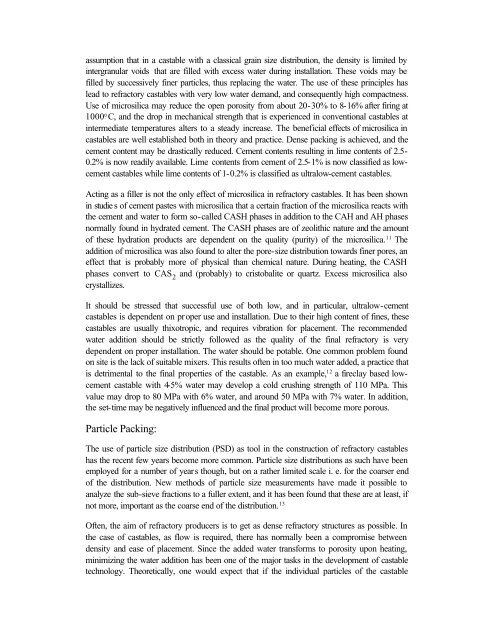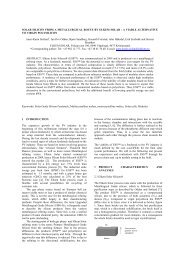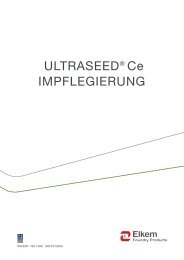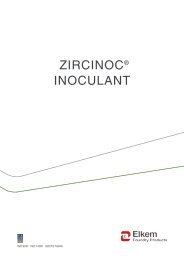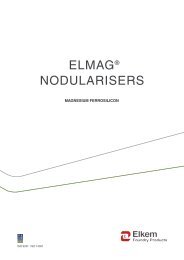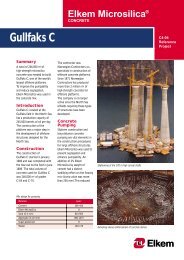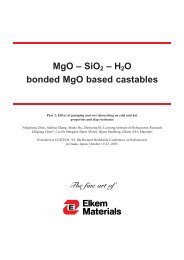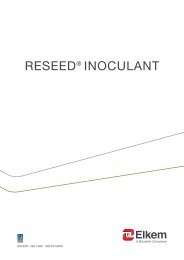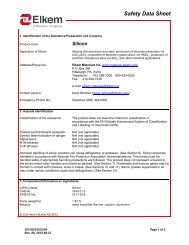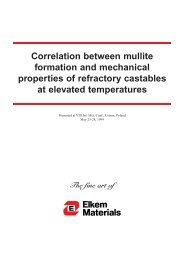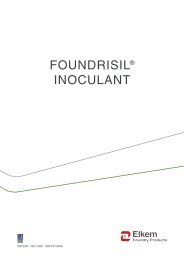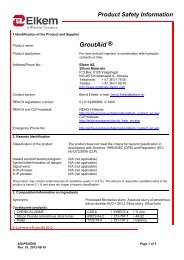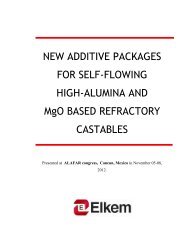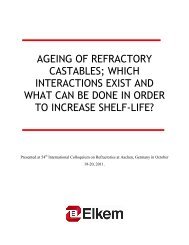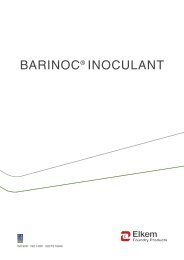The Use of Microsilica in Refractory Castables - Elkem
The Use of Microsilica in Refractory Castables - Elkem
The Use of Microsilica in Refractory Castables - Elkem
- No tags were found...
Create successful ePaper yourself
Turn your PDF publications into a flip-book with our unique Google optimized e-Paper software.
assumption that <strong>in</strong> a castable with a classical gra<strong>in</strong> size distribution, the density is limited by<strong>in</strong>tergranular voids that are filled with excess water dur<strong>in</strong>g <strong>in</strong>stallation. <strong>The</strong>se voids may befilled by successively f<strong>in</strong>er particles, thus replac<strong>in</strong>g the water. <strong>The</strong> use <strong>of</strong> these pr<strong>in</strong>ciples haslead to refractory castables with very low water demand, and consequently high compactness.<strong>Use</strong> <strong>of</strong> microsilica may reduce the open porosity from about 20-30% to 8-16% after fir<strong>in</strong>g at1000°C, and the drop <strong>in</strong> mechanical strength that is experienced <strong>in</strong> conventional castables at<strong>in</strong>termediate temperatures alters to a steady <strong>in</strong>crease. <strong>The</strong> beneficial effects <strong>of</strong> microsilica <strong>in</strong>castables are well established both <strong>in</strong> theory and practice. Dense pack<strong>in</strong>g is achieved, and thecement content may be drastically reduced. Cement contents result<strong>in</strong>g <strong>in</strong> lime contents <strong>of</strong> 2.5-0.2% is now readily available. Lime contents from cement <strong>of</strong> 2.5-1% is now classified as lowcementcastables while lime contents <strong>of</strong> 1-0.2% is classified as ultralow-cement castables.Act<strong>in</strong>g as a filler is not the only effect <strong>of</strong> microsilica <strong>in</strong> refractory castables. It has been shown<strong>in</strong> studie s <strong>of</strong> cement pastes with microsilica that a certa<strong>in</strong> fraction <strong>of</strong> the microsilica reacts withthe cement and water to form so-called CASH phases <strong>in</strong> addition to the CAH and AH phasesnormally found <strong>in</strong> hydrated cement. <strong>The</strong> CASH phases are <strong>of</strong> zeolithic nature and the amount<strong>of</strong> these hydration products are dependent on the quality (purity) <strong>of</strong> the microsilica. 11 <strong>The</strong>addition <strong>of</strong> microsilica was also found to alter the pore-size distribution towards f<strong>in</strong>er pores, aneffect that is probably more <strong>of</strong> physical than chemical nature. Dur<strong>in</strong>g heat<strong>in</strong>g, the CASHphases convert to CAS 2and (probably) to cristobalite or quartz. Excess microsilica alsocrystallizes.It should be stressed that successful use <strong>of</strong> both low, and <strong>in</strong> particular, ultralow-cementcastables is dependent on proper use and <strong>in</strong>stallation. Due to their high content <strong>of</strong> f<strong>in</strong>es, thesecastables are usually thixotropic, and requires vibration for placement. <strong>The</strong> recommendedwater addition should be strictly followed as the quality <strong>of</strong> the f<strong>in</strong>al refractory is verydependent on proper <strong>in</strong>stallation. <strong>The</strong> water should be potable. One common problem foundon site is the lack <strong>of</strong> suitable mixers. This results <strong>of</strong>ten <strong>in</strong> too much water added, a practice thatis detrimental to the f<strong>in</strong>al properties <strong>of</strong> the castable. As an example, 12 a fireclay based lowcementcastable with 4-5% water may develop a cold crush<strong>in</strong>g strength <strong>of</strong> 110 MPa. Thisvalue may drop to 80 MPa with 6% water, and around 50 MPa with 7% water. In addition,the set-time may be negatively <strong>in</strong>fluenced and the f<strong>in</strong>al product will become more porous.Particle Pack<strong>in</strong>g:<strong>The</strong> use <strong>of</strong> particle size distribution (PSD) as tool <strong>in</strong> the construction <strong>of</strong> refractory castableshas the recent few years become more common. Particle size distributions as such have beenemployed for a number <strong>of</strong> years though, but on a rather limited scale i. e. for the coarser end<strong>of</strong> the distribution. New methods <strong>of</strong> particle size measurements have made it possible toanalyze the sub-sieve fractions to a fuller extent, and it has been found that these are at least, ifnot more, important as the coarse end <strong>of</strong> the distribution. 13Often, the aim <strong>of</strong> refractory producers is to get as dense refractory structures as possible. Inthe case <strong>of</strong> castables, as flow is required, there has normally been a compromise betweendensity and ease <strong>of</strong> placement. S<strong>in</strong>ce the added water transforms to porosity upon heat<strong>in</strong>g,m<strong>in</strong>imiz<strong>in</strong>g the water addition has been one <strong>of</strong> the major tasks <strong>in</strong> the development <strong>of</strong> castabletechnology. <strong>The</strong>oretically, one would expect that if the <strong>in</strong>dividual particles <strong>of</strong> the castable


